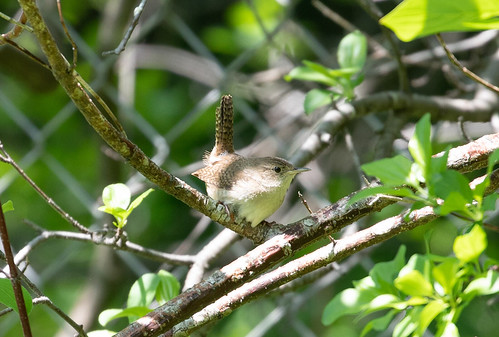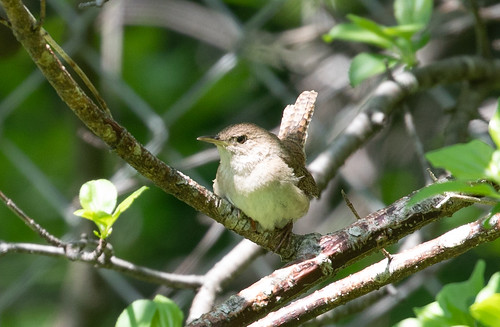June 16, 1975, is a date firmly embedded in my brain—the first day of my first college ornithology class. Russ and I were both taking classes at the Kellogg Biological Station in Kalamazoo that summer. We had to leave ridiculously early on Mondays and Thursdays to get from Lansing to Kalamazoo by 6 am for my ornithology class. Russ’s class didn’t start until the more civilized hour of 8, but we were car-pooling so he was stuck.
That first day, we spent the morning indoors until 10:15—the class was a combination of field and lab study, and the introduction and first lab session came before going outside to look at living birds. And one of the first birds we found was a House Wren. I don’t know how I’d missed that bubbly song all spring. I’m sure some had to be singing when I was birding around the Michigan State campus, but that day we found at least three singing birds, at 10:45 am, 12:15 pm, and 4:45 pm, and after that, I never forgot the song and always associated House Wrens with singing throughout the day. It still mystifies me how once I finally identified various common species, suddenly I found them all around, as if they had newly come into existence, not that I had newly become aware.
I never forgot how my lifer House Wren’s entire body pulsated with the energy of his song. It was one of the coolest things I’d ever seen, though I was noticing that many of the birds I first saw that spring were also each one of the coolest things I’d ever seen. Small wonder in 2020 that so many newspapers and magazines are reporting that people are turning to birdwatching during this pandemic. Just thinking about other people hearing and watching, for the first time, a House Wren singing gives me a surge of joy. How can anyone not thrill at this tiny bird's enormous intensity? In 1919, John Burroughs wrote:
Probably we have no other familiar bird keyed up to the same degree of intensity as the house wren. He seems to be the one bird whose cup of life is always overflowing. The wren is habitually in an ecstasy whether of delight or of rage. He probably gets on the nerves of more persons than any other of our birds. He is so shrilly and overflowingly joyous, or else so sharply and harshly angry and pugnacious – a lyrical burst one minute, and a volley of chiding, staccato notes the next. More restless than the wind, he is a tiny dynamo of bird energy.
This year, three House Wrens have established territories in the backyards around and including mine. Whenever one of them starts singing, the others quickly join in, so it’s hard to go outside without hearing them. When I go outside before 5 am, at least one is already singing. On Saturday, I managed to get up early enough to start my recording at 4:22. A male House Wren started singing persistently at 4:34, a full 41 minutes before sunrise, and he kept at it for over 29 minutes, singing 294 songs without a break. (You can hear this recording here.)
I looked up the House Wren entry in the Cornell Lab of Ornithology and American Ornithological Society’s Birds of the World. It said that the longest bouts of singing last about 4 minutes but can go more than 10 minutes, not even hinting that one might go almost three times that, though in another place, it noted that a male still seeking a mate might sing 600 songs per hour. And the only mention of what time of day House Wrens start singing was a mention of two males near Washington, D.C., who consistently began singing 20-15 minutes before sunrise. I talked to my bird song hero, Donald Kroodsma, about it, and he said that “no one goes out and studies singing behavior before sunrise,” and that it’s “perfectly normal for a House Wren or almost any other song bird to sing for 35 to 40 minutes before sunrise.” I thought that was going to be the biggest song burst I’d hear this year, but then on June 9, even though I didn’t start until 5:10 one little guy piped in around 6:30 and kept going strong for over 70 minutes.
Next year I’m going to try to scrape up the money to get one of Cornell’s Swift Audio Recorders, which I could program to record for several hours every day, rain or shine, starting at 3:30 am so even when I'm out of town or sleeping in, I won’t miss anything. It would be interesting to record what time of morning each species first sings from day to day over a full season.
But for this season, my little Zoom recorder will have to do. Even when I’m not starting too much before dawn, my wrens are delightful. And whether I’m in my backyard listening live or listening to my recordings of my little wrens, I think of how Neltje Blanchan described them in her charming 1897 book, Bird Neighbors (available via Project Gutenberg).
Early some morning in April there will go off under your window that most delightful of all alarm-clocks – the tiny, friendly house wren, just returned from a long visit south. Like some little mountain spring that, having been imprisoned by winter ice, now bubbles up in the spring sunshine, and goes rippling along over the pebbles, tumbling over itself in merry cascades, so this little wren's song bubbles, ripples, cascades in a miniature torrent of ecstasy.



